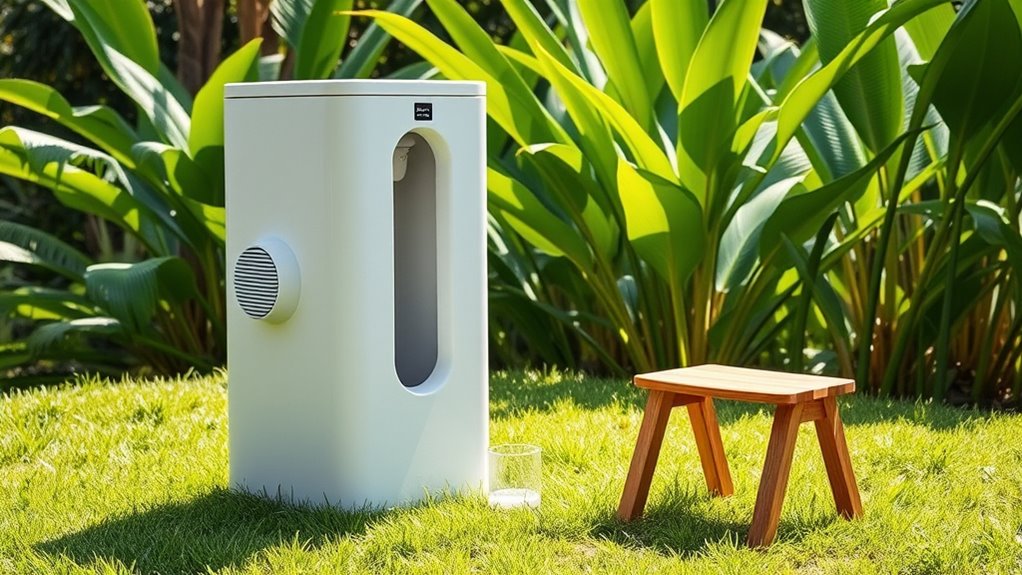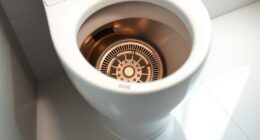Urine-diverting dry toilets provide a sustainable sanitation solution by separating urine from feces, which helps conserve water and reduces environmental pollution. They use specialized designs that direct urine into collection containers, making waste management easier and safer. Collected urine is rich in nutrients like nitrogen and phosphorus, so you can reuse it as fertilizer, closing the nutrient loop. To discover how this innovative system can benefit your community or project, keep exploring the details.
Key Takeaways
- Urine-diverting dry toilets separate urine from feces, reducing odors and simplifying waste management.
- They utilize waterless, sealed chambers that minimize environmental contamination and facilitate composting.
- Collected urine is rich in nutrients, allowing for reuse as natural fertilizer and closing the nutrient loop.
- These toilets require minimal infrastructure, making them ideal for remote or water-scarce areas.
- They promote sustainable sanitation by conserving water, reducing pollution, and supporting eco-friendly waste practices.

Urine-diverting dry toilets are innovative sanitation solutions designed to separate urine from feces, making waste management more sustainable and environmentally friendly. When you use a urine-diverting dry toilet, you’ll notice how straightforward the urine separation process is, thanks to the specialized dry toilet design. These toilets are crafted to divert urine away from the fecal matter immediately upon use, which helps prevent odors and reduces the risk of pathogen spread. The design typically involves a dual-chamber system or separate outlets, ensuring each waste stream remains distinct throughout the process.
Urine-diverting dry toilets separate waste efficiently, promoting sustainability and reducing odors in eco-friendly sanitation.
The dry toilet design is central to the efficiency of urine-diverting toilets. Unlike conventional toilets that rely on water to flush waste away, these systems operate without water, making them ideal for areas with limited water resources. The dry toilet design often includes a urine diversion chamber and a solid waste chamber, both of which are sealed to minimize smells and facilitate waste processing. The urine chamber is usually equipped with a spout or outlet that directs urine into a collection container or drain, while the fecal waste stays in its designated compartment. This separation simplifies composting and other waste treatment methods, transforming human waste into valuable compost or fertilizer.
Additionally, the rise of digital payment solutions is making it easier for communities to manage sanitation programs and funding, emphasizing the importance of sustainable infrastructure investments. The benefits of urine separation are substantial. Urine contains most of the nutrients, like nitrogen, phosphorus, and potassium, which are essential for plant growth. By collecting urine separately, you can reuse it as a fertilizer, reducing the need for synthetic alternatives and closing the nutrient loop. This process not only conserves water but also minimizes the environmental impact of waste disposal. The dry toilet design makes this possible by providing a contained and hygienic way to manage waste, even in remote or off-grid locations.
Furthermore, these toilets are easy to maintain. Since they don’t rely on water, there’s no need for complex plumbing or sewage systems. Regular emptying of the urine collection container and proper handling of fecal matter are all that’s required to keep the system functioning smoothly. The dry toilet design also reduces the risk of leaks and contamination, making it safer for users and the environment. Overall, urine-diverting dry toilets exemplify sustainable sanitation by promoting resource recovery, conserving water, and reducing pollution. They are a practical solution for communities aiming to implement eco-friendly waste management practices, especially where traditional infrastructure is unavailable or impractical.
Frequently Asked Questions
How Do Urine-Diverting Dry Toilets Handle Odor Control?
You’ll find that urine-diverting dry toilets handle odor control effectively through air filtration and odor neutralizers. The air filtration system captures smells, preventing them from escaping, while odor neutralizers chemically break down odors, keeping the environment fresh. Regular maintenance, like adding sawdust or ash, also helps absorb moisture and odors. Together, these methods guarantee your toilet remains odor-free and hygienic, making it suitable for sustainable sanitation needs.
What Maintenance Is Required for Urine-Diverting Dry Toilets?
You’ll need to regularly check and empty the compost chamber to prevent overflow. For maintenance, inspect the biological treatment process, ensuring the composting material remains effective and materials stay durable. A case study from a rural community shows that routine monitoring and adding carbon-rich material help maintain odor control and system efficiency. Keep the ventilation system clean and functioning, and replace worn-out parts promptly for reliable operation.
Are Urine-Diverting Dry Toilets Suitable for Urban Areas?
Yes, urine-diverting dry toilets can work in urban areas, but you need to take into account urban infrastructure and space constraints. These toilets are compact and eco-friendly, making them suitable for cities with limited space. However, you’ll need proper waste management systems and access to sanitation infrastructure. Planners should evaluate local regulations and space availability to ensure seamless integration into urban environments, promoting sustainable sanitation solutions.
How Is the Collected Urine Safely Recycled or Disposed Of?
Think of urine as a treasure chest waiting to be opened. You can safely recycle it through proper urine treatment, which neutralizes pathogens and reduces odor. This process allows nutrient recovery, turning waste into valuable fertilizers for agriculture. If disposal is necessary, follow local regulations to guarantee environmentally safe disposal methods. Proper handling ensures the urine’s nutrients are reused sustainably, protecting both health and the environment.
What Is the Cost Comparison With Traditional Flush Toilets?
You’ll find that urine-diverting dry toilets generally have higher installation expenses upfront but lower ongoing costs. A thorough cost analysis shows they save money over time because they don’t require water or sewer connections, reducing utility bills. While the initial investment might be higher, the long-term savings and environmental benefits make them an economical choice compared to traditional flush toilets, especially in areas with limited water resources.
Conclusion
You now see how urine-diverting dry toilets offer a smart, sustainable solution for sanitation. They turn waste into resources, reducing environmental impact and conserving water. Embracing this technology is like hitting two birds with one stone—you improve hygiene while protecting our planet. By adopting these toilets, you help build a healthier, more sustainable future where everyone benefits. It’s a small change that can make a big difference in creating a cleaner, greener world.









